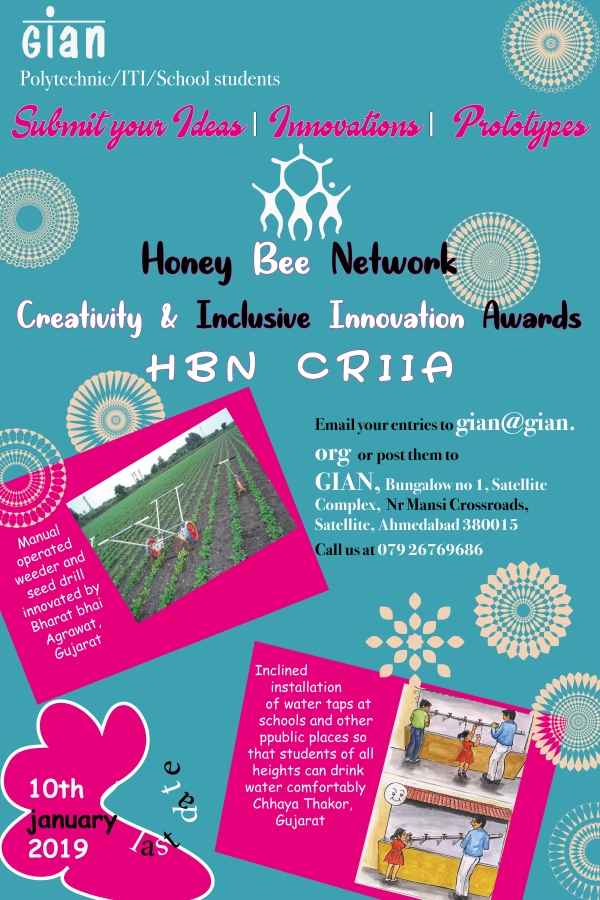Nurturing Creative, impatient and innovative children:
Every parent wishes a bright future for their children, but many times they take too much care, hold the hand of children too tight and in the process stifle the creativity of their children. How can we let children become more autonomous and responsible for shaping their future at their own terms?
During our shodhyatras in different parts of the country, we organize creativity competition among children in villages, schools and even on the roadside when children gather out of curiosity. One thing which never fails to inspire us that children are always willing to try to imagine solutions to various problems around us. Of course in urban areas, idea of using sensors to sense various needs and trigger response seems to dominate, but in other areas, a variety of ideas emerge. How do we make children more sensitive towards the unmet social needs around them so that they learn to be impatient with inertia?
First lesson is to sustain the curiosity of the children. Many times children ask questions of which parents have no ready answer. Often majority of parents just dismiss these questions on one or other pretext. They don’t admit their ignorance and do not make an effort to find out experts who could answer that question properly. This is a widespread practice of killing the curiosity of children and must be avoided.
Second lesson is to expose children to situations where common people or children face various social, economic or physical handicap. This will hopefully generate samvedansheelta (empathy) among children towards those who are less privileged. Once they begin to see their difficulties, they might like to individually or jointly with them to imagine solutions.
Third lesson is not to make things for children. A very large number of parents and teachers actually conceive, implement and fabricate a gadget or device for the children and ask them to showcase it in various science and innovation exhibitions as their own model or idea. There could not be a better way of not only killing the experimental ethic of children but also eroding the ethical foundation of the child. Once a child learns to claim something as his own when it is not his or her original idea and has not been made by her, she may repeat such behaviour. The social fabric of a creative, compassionate and constructive society may have been ruptured forever. This must be avoided at all costs. Let the children Be. Whether they get a prize or not is of lesser consequence, what matters more is to nurture originality, the fertility of imagination, Do-It-Yourself (DIY) culture by sharpening implementing and design faculties of the children. The organizers of various competitions must also test this ability of the children by disconnecting certain wires in the circuits or dismantling certain feature in the gadgets and asking children to reassemble.
Fourth lesson is to acknowledge all help explicitly and meticulously. A knowledge society grows on the foundation of trust, transparency and togetherness. It is true that seldom can most solutions be devised alone, one needs the cooperation of many in implementing a solution. Why not acknowledge respective contributions explicitly. Such a value when seeded at an early stage will hold such children in good stead and help them grow into original thinker and doers.
Firth lesson is to undergo immersive experience about the problem one wants to solve. When the Honey Bee Network has organized children creativity workshops as a part of Festival of Innovation organized by NIF earlier and also at SRISTI or GIAN, young children are encouraged to pursue action- research. They go to slums, craftspeople or other locations where economically poor people live and then try to learn from them, observe their practices, ask questions, try to immerse in the local context to some extent and then identify the unmet social or individual needs. After returning from a field visit, they try to imagine solutions individually or in groups with other children. When they present their insights of how did they identify a problem, what do they think can be done to solve the problem, they have already started walking on the path of samvedana se srijansheelta, empathetic learning, doing and being.
There are many other lessons that I will share in future issues of Honey Bee Network newsletter. What I have tried to stress is that many ideas by children being recognized at Ignite function do indicate such sensitivity. In most cases, children have just given ideas and the NIF’s engineering team has designed and converted the children’s ideas into practical functional prototypes and products. This is fine, particularly when children are too young to acquire the skill of fabrication. It also has given confidence to children that there are platforms in the country which will help them convert their creative ideas into reality. They must feel empowered to imagine and imagine freely and empathetically. NIF also files a patent for such products made by its team in the name of children and assigns all the rights for possible commercialization to such children.
Is not it fair to expect that such children, when they grow into the leaders of future India will show similar solidarity with creative but socio-economically constrained children and other citizens?
I compliment team NIF and all other volunteers of the Honey Bee Network who help in discovering creative ideas of such children and giving wings, as Dr A P J Abdul Kalam often said, to their dreams.
last date dec 31, 2019

